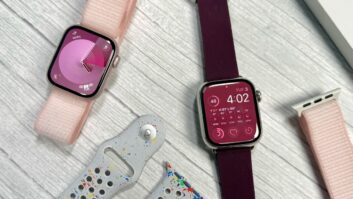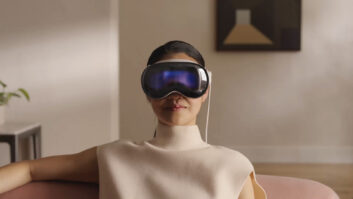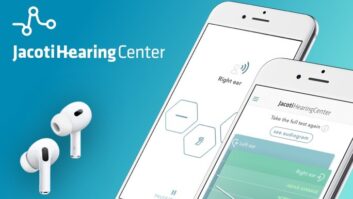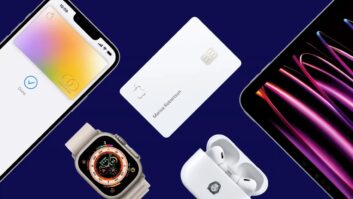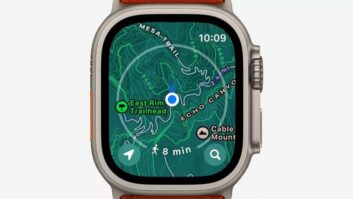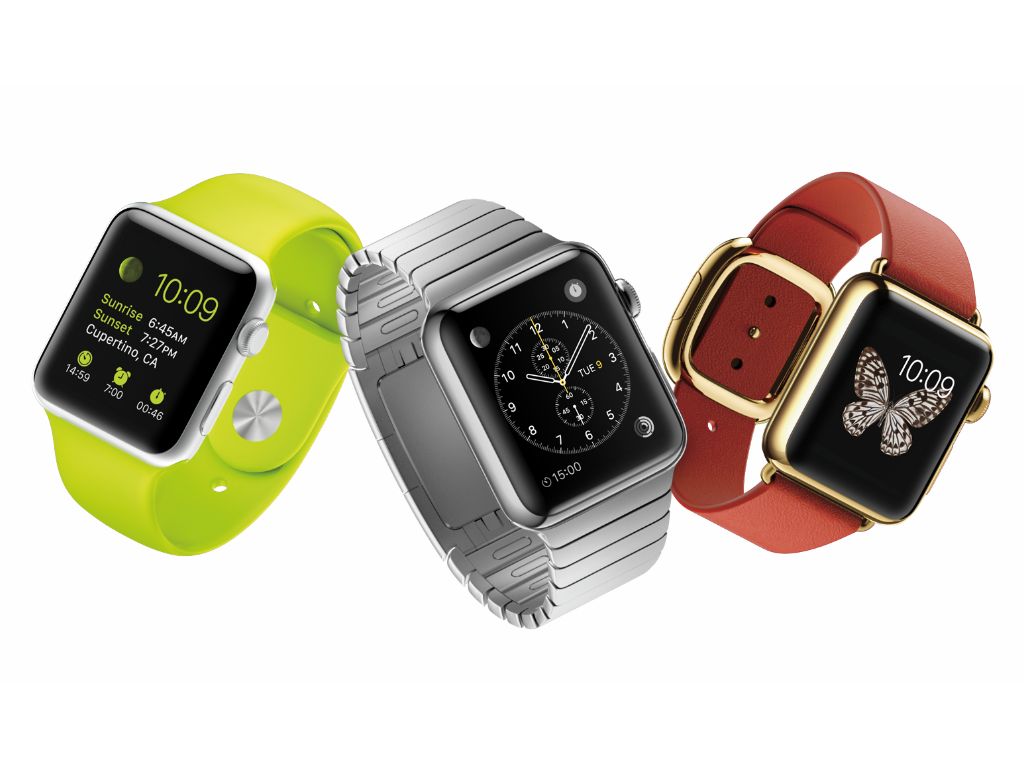
New York — Analysts are already saying the Apple Watch will top the market-share charts in 2015 despite less-than-a-day battery life and premium pricing.
The Apple Watch will lift demand for all brands of smart watches and will continue to move Apple in the direction of a lifestyle company and a luxury brand by focusing on fashion, jewelry-like design and craftsmanship, analysts said.
The Watch will be available in three styles, or collections, each collection available with 38mm and 42mm face sizes, choice of finishes, and multiple bands, allowing for dozens of combinations. Strap options include leather, stainless-steel link, stainless-steel mesh and elastomer, among many others.
The starting price point will be $349 for the Watch collection, which features silver or black stainless-steel case and a hardened sapphire-crystal display. The Apple Watch Sport collection will be available in Space Gray or silver anodized aluminum case and sport band. The Apple Watch Edition will feature 18-karat Rose Gold or Yellow Gold case.
All come with inductive charging for a quick charging connection that snaps into place.
For even more cosmetic options, the watches come with 11 watch faces ranging from traditional analog faces to a face with a real-time 3D model of the Earth, sun, moon and planets.
All watches will connect via Bluetooth 4.0 to iPhone 5 and later phones running iOS 8 to send and receive messages, view notifications from a wide assortment of iPhone apps, answer calls using a built-in speaker and microphone, and use NFC and Apple Pay to pay for purchases at retail.
They also delivers a wide range of other features, such as turn-by-turn navigation, Siri control, and health and fitness apps in a square wristwatch available in three models and two sizes. (For an expanded list of features, see this story.)
Unlike other smart watches, Apple Watch turns the traditional watch stem into a “digital crown” that acts as a scrolling mouse to navigate the apps displayed on the watch display. The crown also lets users magnify the display.
These differences, and Apple’s name and marketing budget, will take Apple to the top among dozens of smart watch vendors, including such powerful bands as Samsung, LG, Motorola and Sony, whose products have retailed for less than Apple’s opening $349. In fact, at $399, or $199 with AT&T contract, Samsung’s Gear S, based on the proprietary Tizen OS, offers built-in 2G/3G cellular to place voice calls and send messages independent of a smart phone.
Smartwatches using the rival Android Wear OS are likewise priced lower than the opening-price Apple Watch. Samsung’s Gear Live is $199, while the LG G Watch R and Motorola Moto 360 are $299. Among lesser known brands, Burg offers a $199 smart watch with built in cellular for voice calls and texting, and Cogito offers a $99 model that provides notifications, features fitness functions, and has NFC for mobile payments. Pebble s also offers smart watches below Apple’s opening price point.
Despite the price disparity, Strategy Analytics forecasts that Apple will ship 15 million watches worldwide in 2015 out of total global shipments of 28.1 million units, giving Apple a 55 percent market share.
Global smartwatch shipments will soar 511 percent to 28.1 million units in 2015 mostly because of the Apple Watch, said Strategy Analytics director Cliff Raskind.
Executive director Neil Mawston called the Apple Watch “the catalyst to ignite the global smartwatch market” because of Apple’s brand name, fan base, deep retail presence and extensive apps.
Nonetheless, Mawston said, “Apple’s first-generation Watch is not yet perfect.” He called it “arguably less attractive than some rival models such as the Huawei Watch.” A battery life of almost a day “might not be as long as many traditional wristwatch owners are used to,” he continued, and Apple’s premium pricing “may be challenging for mass-market consumers.” Apple, he said, “will need to upgrade tangibly its second-generation Watch to stay ahead of competitors later this year.”
For her part, Gartner analyst Annette Zimmermann said Apple Watch “is bound to trigger more awareness for wearables, and Samsung, Sony, Lenovo and others will have to come up with more attractive products to compete.”
Gartner forecasts that shipments of smartwatches, fitness bands and other trackers will jump 38 percent in 2015 to almost 70 million units. These devices, Zimmermann noted, won’t replace smartphone in the next five years but will be complementary devices.
Though the Apple Watch won’t be the first smart watch with NFC-based mobile payment, it will be the most widely known, and wearable technology will help mobile payments take off, said Dan Wagner, founder and CEO of eCommerce technology specialist Powa Technologies, “Wearable tech has a strong synergy with mobile payments, and research has found that four in 10 would use wearables to make in-store payments. However, only 12.2 per cent of smartphone users currently rate mobile payments as the main reason to invest in a wearable device.” He also said smart watches “will need to be much more widely accepted and accessible among consumers before they make a significant impact on retail and brand strategy.”
Whatever its impact on mobile payments, the Apple Watch will also figure prominently in wearable health and fitness monitoring, and 81 percent of consumers already know the device includes digital health and fitness monitoring, according to a HealthMine survey of 561 consumers who have company-sponsored health plans. HealthMine is a health technology company.
The HealthMine survey found age will play a significant role in demand for the Apple Watch. Forty-six percent of people age 18 to 34 are interested in getting it to track their health, but 38 percent of people age 35 to 54 are interested. Sixty percent of individuals age 55 and older are not interested in getting an Apple Watch to track health, the survey found.
The survey also revealed that the desktop/laptop computer is still the top choice among consumers to access their health information. For people aged 18 to 54, the smartphone is a second choice for accessing health data. For respondents 55 and older, a smart phone is the last preference.
Gartner’s Zimmermann agreed that health will be a major focus of Apple as well as Google and Microsoft. “Samsung, Google, Apple and Microsoft are ready to build out entire health platforms that are intended to attract partners in the healthcare and fitness industry,” she said. “This initiative will trigger new business models but will also stir up the discussion on how best to protect the sensitive data that is being collected from wearables.” She also noted that “there is still room for improvement for most vendors to create more sophisticated apps and ecosystems around wearables.”
Another consumer survey found that most consumers intending to buy a wearable don’t plan to buy the Apple Watch, but Apple doesn’t need a majority to take top smart watch share as long as it gets a small percentage of its large iPhone user base to opt for the Watch.
Accent, a provider of omni-channel customer engagement solutions for brands, found in surveying 1,000 consumers who own or plan to buy wearable technology this year that four out of five do not plan to buy the Apple watch. That’s despite the belief by 54 percent of wearable consumers that the Apple Watch is “an exciting use of technology.” In addition, 51 percent of wearable consumers believe the Apple watch interface will be too small to use.
In addition, the survey found that:
- Thirty-eight percent) of men say they are most excited about wearable tech watches.
- Sixty-four percent of wearable consumers surveyed use their wearable tech device daily.
- Two out of three consumers want access to Facebook, Instagram, Twitter via a wearable device.




